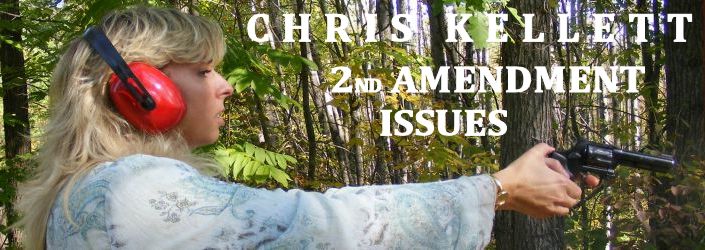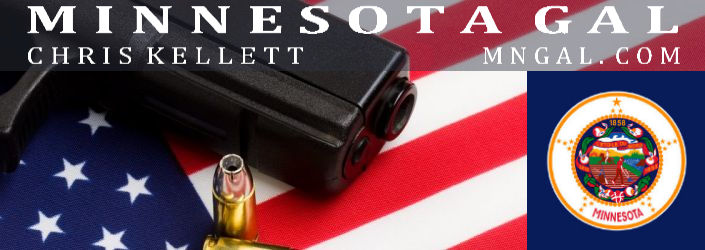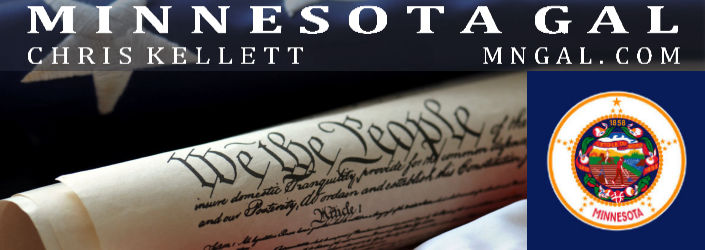 |























|
Vote Chris Kellett for State Representative District 10A
HR-218 Law Enforcement Officers Safety Act (LEOSA)
50-State Permit to Carry
It is an undeniable fact that criminals have very good memories when it comes to the person (or people) responsible for holding them accountable for their criminal actions and helping them face the consequences they deserve. Even after these law enforcement officers retire, doesn't mean that the criminals have forgotten them and the retired officers can be very much at risk.
It is also a fact that should be recognized that our retired, highly experienced and trained officers are an asset to the public, especially in a dangerous situation where citizens are at risk of death or great bodily harm by an attacker. Most retired officers would likely want to intervene as they are not only skilled at, but are dedicated to saving lives and that does not end simply beciuse they have retired.
On July 22, 2004, George W. Bush recognized these facts and signed into law H.R. 218, the Law Enforcement Officers Safety Act (LEOSA) which gives officers, both active and retired the right to carry a firearm in all 50 states. While retired officers are not given any special enforcement or arrest authority or immunities, and while there are still limitations and rules in each state they are requred to follow, it is a step in the right direction.
Qualified retired officers must have retired in good standing after serving for a minimum of 10 years (unless the retirement was due to a service related disability*) and must meet the state standard for firearms qualification required for active law enforcement officers. They must have a photo ID from the agency they work for and a certification that they have met the requirements to carry concealed. This certification will need to be renewed annually. Please see below for the full description.
In order to get this certification, you can click here to sign up for a class or ask me any questions. Usually when I get a contact I will contact other retired law enforcement officers who are about to expire and try to group you into a small class which goes fairly quickly. If I can't, I do classes for individuals also. We fill out some paperwork, I will go over the basics of the law so you have the information you need to know as you travel and then we do the shooting exercise. While I usually do these at the Mills Indoor Shooting & Archery range in Baxter, I can meet you at a range closer to your location.
I also can combine the class and include the Minnesota Permit to Carry Course as well, which will give you fewer limitations in Minnesota (and in some other states who recognize MN) than the federal 50-state permit.
I am more than happy to schedule private classes in your area. The more retired officers and good citizens we have carrying, the safer we ALL are.
Thank you for your service.
Chris
HR 218/Law Enforcement Officers Safety Act
LEOSA, as Amended by the National Defense Authorization Act of 2013 (Jan 2, 2013)
(Changes have been italicized.)
§ 926B. Carrying of concealed firearms by qualified law enforcement officers
(a) Notwithstanding any other provision of the law of any State or any political subdivision thereof, an individual who is a qualified law enforcement officer and who is carrying the identification required by subsection (d) may carry a concealed firearm that has been shipped or transported in interstate or foreign commerce, subject to subsection (b).
(b) This section shall not be construed to supersede or limit the laws of any State that--
(1) permit private persons or entities to prohibit or restrict the possession of concealed firearms on their property; or
(2) prohibit or restrict the possession of firearms on any State or local government property, installation, building, base, or park.
(c) As used in this section, the term "qualified law enforcement officer" means an employee of a governmental agency who--
(1) is authorized by law to engage in or supervise the prevention, detection, investigation, or prosecution of, or the incarceration of any person for, any violation of law, and has statutory powers of arrest or apprehension under section 807(b) of title 10, United States Code (article 7(b) of the Uniform Code of Military Justice);
(2) is authorized by the agency to carry a firearm;
(3) is not the subject of any disciplinary action by the agency which could result in suspension or loss of police powers;
(4) meets standards, if any, established by the agency which require the employee to regularly qualify in the use of a firearm;
(5) is not under the influence of alcohol or another intoxicating or hallucinatory drug or substance; and
(6) is not prohibited by Federal law from receiving a firearm.
(d) The identification required by this subsection is the photographic identification issued by the governmental agency for which the individual is employed that identifies the employee as a police officer or law enforcement officer of the agency.
(e) As used in this section, the term "firearm"--
(1) except as provided in this subsection, has the same meaning as in section 921 of this title;
(2) includes ammunition not expressly prohibited by Federal law or subject to the provisions of the National Firearms Act; and
(3) does not include--
(A) any machinegun (as defined in section 5845 of the National Firearms Act);
(B) any firearm silencer (as defined in section 921 of this title); and
(C) any destructive device (as defined in section 921 of this title).
(f) For the purposes of this section, a law enforcement officer of the Amtrak Police Department, a law enforcement officer of the Federal Reserve, or a law enforcement or police officer of the executive branch of the Federal Government qualifies as an employee of a governmental agency who is authorized by law to engage in or supervise the prevention, detection, investigation, or prosecution of, or the incarceration of any person for, any violation of law, and has statutory powers of arrest or apprehension under section 807(b) of title 10, United States Code (article 7(b) of the Uniform Code of Military Justice)."
§ 926C. Carrying of concealed firearms by qualified retired law enforcement officers
(a) Notwithstanding any other provision of the law of any State or any political subdivision thereof, an individual who is a qualified retired law enforcement officer and who is carrying the identification required by subsection (d) may carry a concealed firearm that has been shipped or transported in interstate or foreign commerce, subject to subsection (b).
(b) This section shall not be construed to supersede or limit the laws of any State that--
(1) permit private persons or entities to prohibit or restrict the possession of concealed firearms on their property; or
(2) prohibit or restrict the possession of firearms on any State or local government property, installation, building, base, or park.
(c) As used in this section, the term "qualified retired law enforcement officer" means an individual who--
(1) separated from service in good standing from service with a public agency as a law enforcement officer;
(2) before such separation, was authorized by law to engage in or supervise the prevention, detection, investigation, or prosecution of, or the incarceration of any person for, any violation of law, and had statutory powers of arrest or apprehension under section 807(b) of title 10, United States Code (article 7(b) of the Uniform Code of Military Justice);
(3)(A) before such separation, served as a law enforcement officer for an aggregate of 10 years or more; or
(B) separated from service with such agency, after completing any applicable probationary period of such service, due to a service-connected disability, as determined by such agency;
(4) during the most recent 12-month period, has met, at the expense of the individual, the standards for qualification in firearms training for active law enforcement officers, as determined by the former agency of the individual, the State in which the individual resides or, if the State has not established such standards, either a law enforcement agency within the State in which the individual resides or the standards used by a certified firearms instructor that is qualified to conduct a firearms qualification test for active duty officers within that State;
(5)(A) has not been officially found by a qualified medical professional employed by the agency to be unqualified for reasons relating to mental health and as a result of this finding will not be issued the photographic identification as described in subsection (d)(1); or
(B) has not entered into an agreement with the agency from which the individual is separating from service in which that individual acknowledges he or she is not qualified under this section for reasons relating to mental health and for those reasons will not receive or accept the photographic identification as described in subsection (d)(1);
(6) is not under the influence of alcohol or another intoxicating or hallucinatory drug or substance; and
(7) is not prohibited by Federal law from receiving a firearm.
(d) The identification required by this subsection is--
(1) a photographic identification issued by the agency from which the individual separated from service as a law enforcement officer that identifies the person as having been employed as a police officer or law enforcement officer and indicates that the individual has, not less recently than one year before the date the individual is carrying the concealed firearm, been tested or otherwise found by the agency to meet the active duty standards for qualification in firearms training as established by the agency to carry a firearm of the same type as the concealed firearm; or
(2)(A) a photographic identification issued by the agency from which the individual separated from service as a law enforcement officer that indicates the person as having been employed as a police officer or law enforcement officer; and
(B) a certification issued by the State in which the individual resides or by a certified firearms instructor that is qualified to conduct a firearms qualification test for active duty officers within that State that indicates that the individual has, not less than 1 year before the date the individual is carrying the concealed firearm, been tested or otherwise found by the State or a certified firearms instructor that is qualified to conduct a firearms qualification test for active duty officers within that State to have met--
(I) the active duty standards for qualification in firearms training, as established by the State, to carry a firearm of the same type as the concealed firearm; or
(II) if the State has not established such standards, standards set by any law enforcement agency within that State to carry a firearm of the same type as the concealed firearm.
(e) As used in this section--
(1) the term "firearm"--
(A) except as provided in this paragraph, has the same meaning as in section 921 of this title;
(B) includes ammunition not expressly prohibited by Federal law or subject to the provisions of the National Firearms Act; and
(C) does not include--
(i) any machinegun (as defined in section 5845 of the National Firearms Act);
(ii) any firearm silencer (as defined in section 921 of this title); and
(iii) any destructive device (as defined in section 921 of this title); and
(2) the term 'service with a public agency as a law enforcement officer' includes service as a law enforcement officer of the Amtrak Police Department, service as a law enforcement officer of the Federal Reserve, or service as a law enforcement or police officer of the executive branch of the Federal Government.